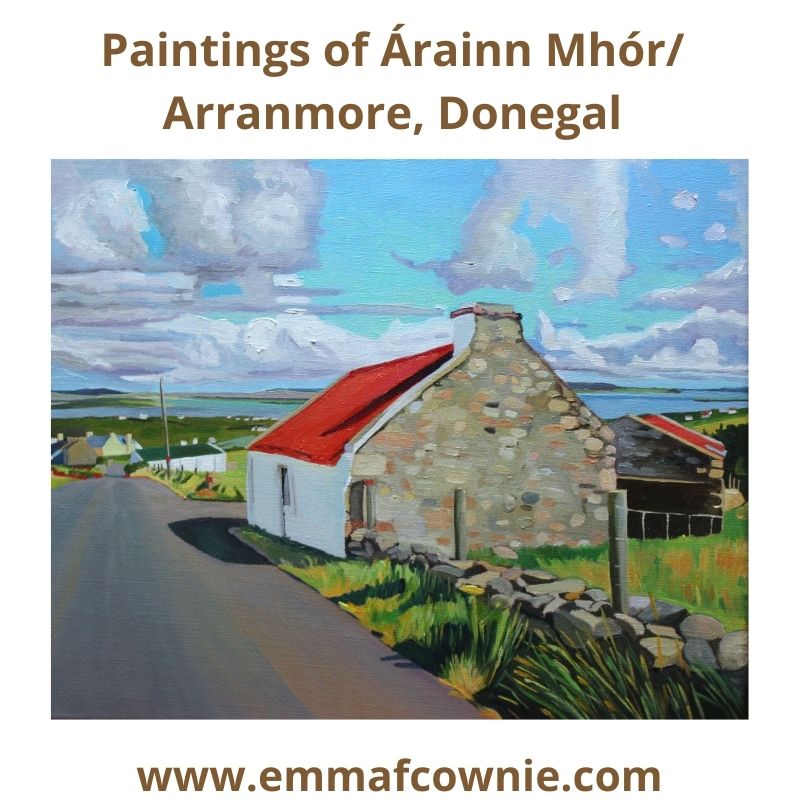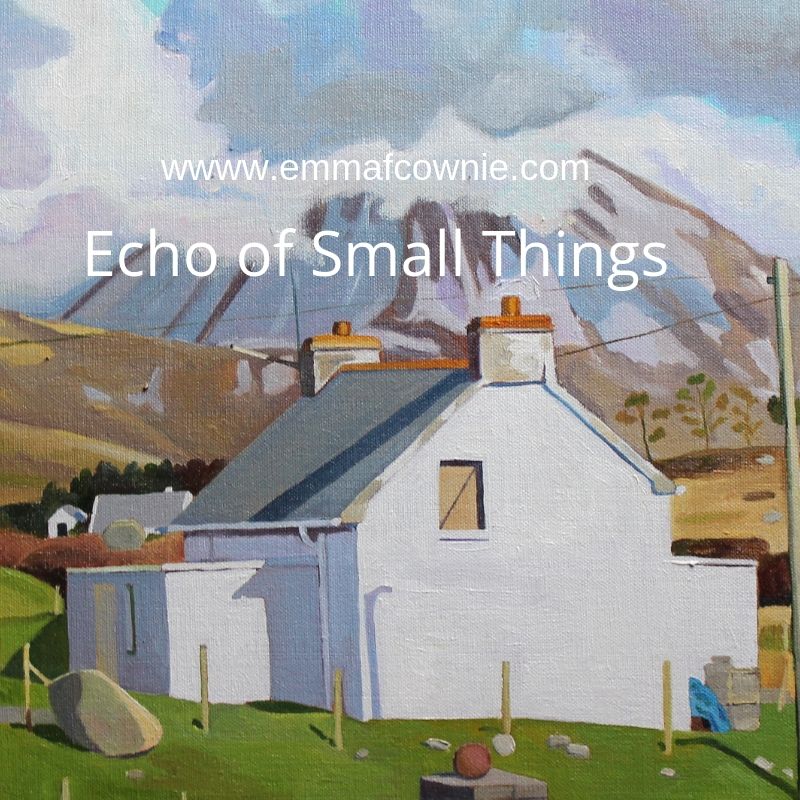
Spring Newsletter










The west coast of Ireland is dotted with islands, big and small but also plenty of sea stacks. Perhaps, they were once sea arches, I am not sure. If they were the crown of the arch fell in to create these majestic pillars. They can be seen from miles away. Even on misty days. This one, Tormore (in the painting above and below) is miles away, near a very remote location called Glenlough Bay. There is something exciting and other worldly and timeless about it.

Rossbeg (sometimes spelt Rosbeg) is a tiny townland on the west coast of Donegal, just three miles south-west of Portnua and Nairn. This is the Dawros Peninsula. There is a pier and a scattering of houses, some are modern, but many are old cottages, probably used as holiday lets.

There is another beach around the corner too.




The beach and the view is just perfect. The water is so very clear that the rocks and seaweed are visible from quite some distance from the shore.



Boat on Rossbeg Beach, Donegal, painting by Emma Cownie
Buy the painting here
I have decided that perfect is the enemy of good, and I need to give up on the idea that I should write lengthy blogs posts, as I end up writing nothing! So here goes,

One of the many great things about being back in West Donegal is that I can paint much larger paintings as my art studio is much bigger here than in Derry. So I now have two on the go!

These are both painted in acrylic paint. I find it easier to make adjustment in the value/tones in acrylic before I move onto a layer of oil as a final layer. Acrylic can act as a foundation layer for oil, but not the other way around. I had forgotten how physically tiring painting a large painting is. My arms are tired!

If you want to know about Greyscaling and why I have adopted this technique since moving to Ireland please see my post “Adventures In Acrylic Paint”

Bloody Foreland is one of my favourite locations in Donegal. It is one of the wildest, windiest and most beautiful places I have been. The light is sharp and clear. You feel healthier for breathing the air here.

The wind is always blowing. It is very remote and feels a bit like the edge of the known-world.

The name Bloody Foreland (Cnoc Fola in Irish means Hill of Blood) does not to refer to some past battle that took place here in mythic times, but intense red hue of the rocks at sunset. The Irish language dominates here.
Folklore records that Balor, the one-eyed supernatural warlord was eventually slain by his grandson Lugh Lámh Fhada on the slopes of Cnoc Fola. Indeed, some say that the tide of blood which flowed from Balor’s evil eye stained the hillside and gave it its name.

I particularly like the incredible stone walls, made of massive granite boulders, that snake across the hills here. They date from the 1890s. They suggest to me a landscape where stones were plentiful and labour cheap. It is also the sort of place where writers come to get away from the modern world and think about writing. Dylan Thomas, travelled to An Port, further south to write poetry, but left without paying his bills.
 Old Farm Buildings, Bloddy Foreland
Old Farm Buildings, Bloddy Foreland
Bloody Foreland, also makes a refreshing contrast to the slopes of Brinlack and Derrybeg, round the corner, which are heavily peppered with larger modern houses and bungalows from the era of “Bungalow Bliss“.

This is the first time that I have been able to paint Ireland whilst in Ireland. Previously, I have worked from my photos back in Wales. Now I think that being surrounded by these colours all the time is affecting my work in a different way.
I am experimenting a little with less detail and letting my under painting show through more – to give a greater sense of the roughness of the landscape here. I am feeling my way. I don’t know how my paintings will develop in the future, but not knowing is a sort of freedom from painting the same thing in the same sort of way.
Up Bloody Foreland, Donegal
Here’s my summer newsletter. I am shutting up shop for a month from 20th June to 20th July. All going well, we will be safely installed and open for business (online at least) in Donegal by mid-July. I am already longing to get back to my painting routine. I can’t quite believe that after being ground so long by my broken leg and the pandemic that we will actually move house/studio to another country by then. It’s a huge step! Fingers crossed it all goes smoothly!

Caravans tucked away on coastal inlets and islands are not an unsual sight in Donegal. I am always impressed by their presence as there are no roads for lorries and it must have taken a good deal of effort and ingenuity to get it there. Getting to have a “Staycation” in 2021 amidst all the uncertainty of vaccine rolls out & third (or is it fourth?) waves looks like it will take an equal amount of effort! So instead join me in imagining the view from the static caravan’s wide window across the rugged terrain of Gola Island on this late spring morning.


I recently join the Stair Árrain Mhór – Árrain Mhór History Facebook group and was overwhelmed by the positive response I received from the members when I put my most recent post online there. I was asked if I had any more paintings of Arranmore for them to see, so here’s a collection of all my paintings of the Island that I have completed in the last two years.
Where it reads (Private Collection) it means that the painting has been sold. I hope you enjoy looking at them.
To see my Donegal paintings for sale click here


















There are also some small watercolours I did when I could not get to my oil paints and easel due to a broken leg/ankle




Some of the above paintings are available to buy as prints on artamajeur.com.

